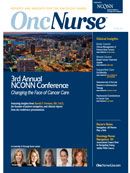Publication
Article
Oncology Nursing News
Navigation: All Nurses Play a Role
Author(s):
Navigation programs in healthcare facilities are proliferating. However, there is considerable variability in their scope and implementation.

Lisa Schulmeister, RN, MN, APRN-BC, OCN®, FAAN
Editor-in-Chief OncLive Nursing
Oncology Nursing Consultant, Adjunct Assistant Professor of Nursing Louisiana State Health Sciences Center in New Orleans, Louisiana
This month’s OncLive Nursing features coverage of the National Coalition of Oncology Nurse Navigators (NCONN) 3rd Annual Changing the Face of Cancer Care Conference. The emergence and success of NCONN is a testament to the rapid growth of nurse navigation as a subspecialty of oncology nursing. As an introduction to our NCONN coverage, here is some background information on nurse navigation, with an emphasis on the important role all nurses can play in navigating patients across the cancer care continuum.
Harold P. Freeman, MD, FACS, founded patient navigation in Harlem, New York, in 1990. As a breast cancer surgeon, he was regularly seeing patients with late-stage cancer who had severely limited treatment options. His orginal focus for patient navigation was to increase the rates of early screening and diagnosis to ensure patients were presenting at earlier stages, when the options for improving survival and quality of life are far greater. In the decades since Freeman originated the concept, navigation has evolved to increasingly focus on guiding patients through the entire cancer care continuum.
NCONN now defines the oncology nurse navigator (ONN) as “a professional whose clinical nursing expertise guides patients, families, and their caregivers to informed decision-making, collaborating with a multidisciplinary team to allow for timely cancer screening, diagnosis, treatment, and increased supportive care across the cancer continuum.” ONNs either guide a general population of patients with cancer, or guide a subpopulation of patients (eg, breast care navigators).
Navigation programs in healthcare facilities are proliferating. However, there is considerable variability in their scope and implementation. Navigation programs are informal in some facilities, while in others they are specialized and have dedicated staff. The Commission on Cancer (CoC) of the American College of Surgeons notes that the variability in navigation services offered at a particular facility can depend on the type, severity, and complexity of identified barriers to accessing cancer care. Examples of frequently encountered barriers that have the potential to be reduced or eliminated through patient navigation include financial barriers, communication barriers, fragmented care, and emotional distress.
The CoC is in the process of phasing in standard 3.1, the Patient Navigation Process, as a component of its accreditation standards (the standard is to be fully implemented by 2015). The standard requires that accredited centers have navigation programs. Specifically, “A patient navigation process, driven by a community needs assessment, is established to address health care disparities and barriers to care for patients. Resources to address identified barriers may be provided either on-site or by referral to community-based or national organizations.”
“
A seamless journey is certainly a better outcome than a rocky road of care, and all nurses can promote a seamless journey. ”
The addition of the new standard addresses the tremendous need to add navigation programs in many parts of the United States. In several areas of the country, navigation programs need to be created to address cancer health disparities identified in the community and incorporate processes that involve collaboration with community-based organizations.
Information on creating and implementing navigation programs is available from NCONN, the Association of Community Cancer Care Centers, the Harold P. Freeman Patient Navigation Institute, and the National Cancer Institute Center to Reduce Health Disparities Patient Navigator Research Program.
Nurse navigation helps ensure that patients with cancer have a seamless journey from the time of diagnosis to survivorship or end-of-life. A seamless journey is certainly a better outcome than a rocky road of care, and all nurses can promote a seamless journey. If there is a navigation program in your facility, or one nearby that your patients are eligible to participate in, refer patients to these programs. If navigation programs or services are not available in your area, conduct a community needs assessment, identify healthcare system barriers, and implement needed navigation services. If you’re already in a nurse navigator role, collect data on outcome measures and share information on your models of care.
Navigation is an essential component of cancer care and has demonstrated efficacy as a strategy to reduce cancer mortality. Navigation is currently also being applied to reduce mortality in other chronic diseases, so its utilization is further expanding. Hopefully, all patients with 1 or more chronic diseases will soon have access to navigation services and programs.

Latest Conference Coverage

Zongertinib Elicits Durable Responses in Pretreated Advanced HER2-Mutant NSCLC

Lenvatinib Shows Efficacy in Advanced HCC Post-Progression on Atezolizumab/Bevacizumab

Sacituzumab Govitecan Does Not Significantly Improve OS in Pretreated Urothelial Carcinoma

Active Monitoring Is Noninferior to Guideline Concordant Care in Low-Risk DCIS
2 Commerce Drive
Cranbury, NJ 08512





